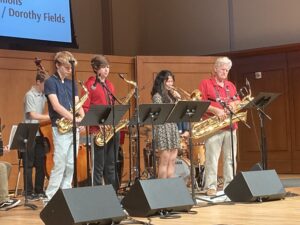If you’re considering the UNC Summer Jazz Workshop, here are some notes that reflect my own experience:
1. Everyone should see jazz performed live.
Live jazz is an incredible thing to witness. I don’t think I’ve ever seen so much live jazz in my life as I have this week. The live jam sessions each day were surprisingly one of my favorite events to attend. It’s so interesting to watch people who have never met before come together and jam almost immediately. There’s so much variability in a jazz performance; while the players are prepared, they also have the freedom to improvise differently every time they pick up their horn.
I also love the way you can watch players communicating with each other in the middle of a performance or jam session. They make quick decisions, listen to each other, and create their roadmap on the spot. It’s incredible, impressive, and invaluable to jazz as a genre.
2. Jazz history is fascinating — and important.
This week I’ve learned so much fascinating information on the history of jazz. Bits and pieces were things I’d heard throughout my life as a young jazz musician in high school — but I’m happy to have gotten a much better look at the big picture of jazz history, its greatest players, and the way the genre has changed through all its ebbs and flows.
Since the beginning of jazz, it has always been evolving. We talked about the genre as if it existed on a pendulum; every preceding era of jazz was a response to the one before it. A common theme was how the young generation were typically the ones to employ their own music tastes and fuse them with jazz styles over time, thus changing the makeup of jazz and its popularity.
3. We’ve got some very talented faculty members.
I’ve had the privilege of working with some of these faculty members before the workshop, but most of them I met for the first time here. I was in awe of their performances during the nightly concerts. Their ability to put together such challenging and impressive sets without much time to prepare blew me away this week.
To be able to learn from a group of staff members who can practice what they preach is so important for musicians, and the jazz workshop is done in a way where you won’t leave without having seen lots and lots of live music — with the UNC faculty members always getting a moment to shine.
4. Be careful — this workshop might inspire you to get more involved with jazz.
I used to play alto sax in a jazz band in high school. I loved it but never felt like I learned enough about theory and improv to be successful. Since then, I’ve strayed from the genre and no longer have other jazz enthusiasts in my life to connect with. After this week, I think I’ll try to slowly get back into jazz — starting by listening to the jazz player I used to love, as well as names I heard for the first time this week.
I really want to be able to be a part of this amazing community of musicians who are practically overflowing with talent and who get to represent one of the coolest genres in our country’s history.
Final thoughts
I had a great time at the UNC Summer Jazz Workshop this year! If you find yourself with even the slightest bit of interest in jazz or journalism, no real music experience, and in need of an Experiential Education credit, then this week-long course is for you. You will leave with a better idea of what jazz is, where it came from, and what it looks like now — while also hearing some very talented participants and faculty throughout the week. Who knows … you might find a new favorite jazz album or musician that you never would have come across otherwise.
